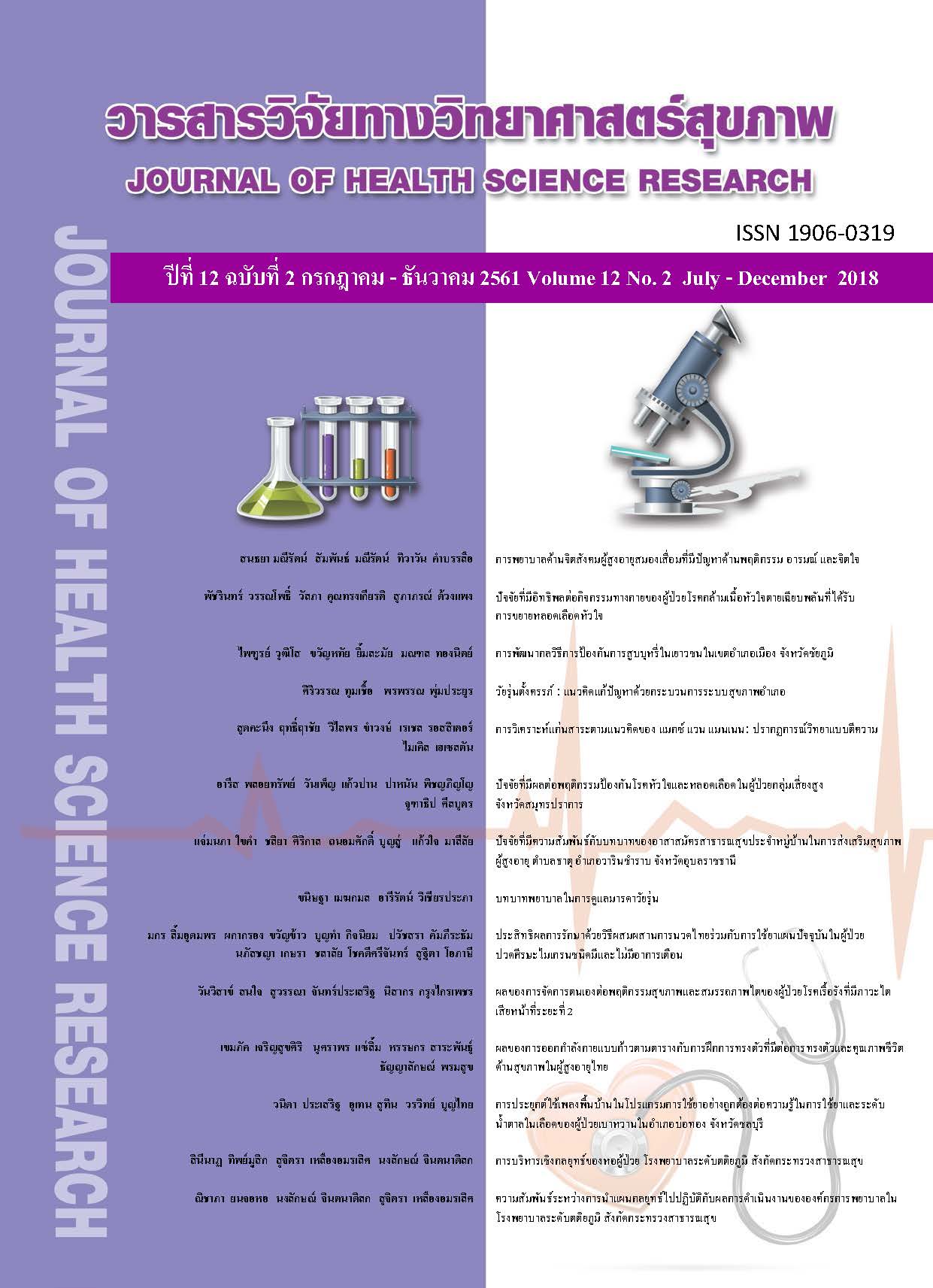ปัจจัยที่มีอิทธิพลต่อกิจกรรมทางกายของผู้ป่วยโรคกล้ามเนื้อหัวใจตายเฉียบพลัน ที่ได้รับการขยายหลอดเลือดหัวใจ
Main Article Content
บทคัดย่อ
การมีกิจกรรมทางกายภายหลังการได้รับการขยายหลอดเลือดหัวใจ มีความสำคัญยิ่งในการป้องกันการกลับเป็นซ้ำของโรคกล้ามเนื้อหัวใจตายเฉียบพลัน การวิจัยครั้งนี้เป็นแบบหาความสัมพันธ์เชิงทำนาย มีวัตถุประสงค์เพื่อศึกษาปัจจัยที่มีอิทธิพล ได้แก่ ความรุนแรงของโรค ความฉลาดทางสุขภาพ การรับรู้สมรรถนะแห่งตน และการสนับสนุนทางสังคม ต่อกิจกรรมทางกายของผู้ป่วยโรคกล้ามเนื้อหัวใจตายเฉียบพลันที่ได้รับการขยายหลอดเลือดหัวใจ คัดเลือกกลุ่มตัวอย่างโดยวิธีการสุ่มอย่างง่าย จำนวน 89 ราย เป็นผู้ป่วยที่มารับการรักษาติดตามที่ งานผู้ป่วยนอกแผนกอายุรกรรม โรงพยาบาลพระปกเกล้า จังหวัดจันทบุรี เก็บข้อมูลระหว่างเดือนสิงหาคม ถึงเดือนตุลาคม พ.ศ. 2560 เครื่องมือวิจัยเป็นแบบสอบถามที่ให้กลุ่มตัวอย่างเป็นผู้ตอบเอง ได้แก่ แบบสอบถามความฉลาดทางสุขภาพ การรับรู้สมรรถนะแห่งตน การสนับสนุนทางสังคม และกิจกรรมทางกาย มีค่าความเชื่อมั่นของสัมประสิทธิ์แอลฟาครอนบาคเท่ากับ .82 .85 .71 และ .81 ตามลำดับ วิเคราะห์ข้อมูลโดยใช้สถิติพรรณนาและวิเคราะห์ถดถอยพหุคูณแบบขั้นตอน
ผลการวิจัยพบว่า ความรุนแรงของโรคเป็นปัจจัยที่มีอิทธิพลมากที่สุดของกิจกรรมทางกาย (β = .562) รองลงมาคือ การสนับสนุนทางสังคม (β = .230) และการรับรู้สมรรถนะแห่งตน (β = .196) ปัจจัยทั้งสามนี้มีอิทธิพลและสามารถร่วมกันทำนายกิจกรรมทางกายของผู้ป่วยโรคกล้ามเนื้อหัวใจตายเฉียบพลัน ที่ได้รับการขยายหลอดเลือดหัวใจได้ร้อยละ 55.00 (R2 = .550, F = 34.606, p < .001)
ผลการวิจัยครั้งนี้สามารถใช้เป็นข้อมูล และเป็นแนวทางในการพัฒนารูปแบบการมีกิจกรรมทางกาย โดยเน้นการรับรู้สมรรถนะแห่งตน และการสนับสนุนทางสังคมแก่ผู้ป่วย
Downloads
Article Details
บทความที่ได้รับการตีพิมพ์เป็นลิขสิทธิ์ของวิทยาลัยพยาบาลบรมราชชนนี จังหวัดนนทบุรี
ข้อความที่ปรากฏในบทความแต่ละเรื่องในวารสารวิชาการเล่มนี้เป็นความคิดเห็นส่วนตัวของผู้เขียนแต่ละท่านไม่เกี่ยวข้องกับวิทยาลัยพยาบาลบรมราชชนนี จังหวัดนนทบุรี และคณาจารย์ท่านอื่น ในวิทยาลัยฯ แต่อย่างใด ความรับผิดชอบองค์ประกอบทั้งหมดของบทความแต่ละเรื่องเป็นของผู้เขียนแต่ละท่าน หากมีความผิดพลาดใด ๆ ผู้เขียนแต่ละท่านจะรับผิดชอบบทความของตนเองแต่ผู้เดียว
เอกสารอ้างอิง
2.International Health Policy Program, Ministry of Health. Disease situation report NCDs No. 2 “kick off to the goals” [Internet]. 2016 [cited 2017 Jan 9]; Available from: http://i-regist.igenco.co.th/web/ dmthai_old/sites/default/files/ncd_nhes_v_2016.pdf. (in Thai).
3. The Heart Association of Thailand under the Royal Patronage of H.M. the King. Guideline for ischemic heart disease 2014. Bangkok: Srimuang Printing; 2014.
4. Budnik M, Opolski G. The assessment of coronary heart disease risk factor correlated with demographic and social data in post-coronary intervention patients in Polish population. Cardiol J. 2015;22(3):276-84.
5. Cajanding RJ. Effects of structured discharge planning program on perceived functional status, cardiac self-efficacy, patient satisfaction, and unexpected hospital revisits among Filipino cardiac patients: A randomized controlled study. J Cardiovasc Nurs. 2017;32(1):67-77.
6.Thanaphatsorn N, Howteerakul N, Sujirarat D, Suwannapong N, Kehasukcharorn W. Incidence and factors associated with instent restenosis in coronary heart disease patients at Chest Disease Institute Nonthaburi Province [Oral Presentation]. In: RSU National Research Conference 2015. 24th April 2015; Thailand. Pathum Thani: Rangsit University; p.201-9. (in Thai).
7.Grady PA, Gough LL. Self-management: A comprehensive approach to management of chronic conditions. Am J Public Health. 2014;24(8):e25-31.
8. Tobin DL, Reynolds RVC, Holroyd KA, Creer TL. Self-management and social learning theory. In: Holroyd KA, Creer TL, editors. Self-management of chronic disease: Handbook of clinical interventions and research. Orlando, NY: Harcourt Brace Jovanovich; 1986. p.29-54.
9. Wattanakitkrileart D. Psychosocial problems in patients with heart and lung disease and nursing care. Journal of Nursing Science. 2009;27(2):22-31. (in Thai).
10.Ritpetch N, Jitpanya C, Chimluang J. Relationships among symptom clusters, self-management, health value, sense of coherence, and health -related quality of life in patients with percutaneous coronary intervention. Princess of Naradhiwas University Journal. 2013;5(1):16-34. (in Thai).
11.World Health Organization. Global Physical Activity Questionnaire (GPAQ): Analysis guide [Internet]. 2016 [cited 2017 Jan 9]; Available from: http://www.who.int/ ncds/surveillance/steps/resources/GPAQ_Analysis_Guide.pdf.
12.Zhao S, Zhang Z, Long Q, Ma Y, Lian X, Yang Y, et al. Association between time of day of sports-related physical activity and the onset of acute myocardial infarction in Chinese population. PLoS One. 2016;11(1):e0146472. doi: 10.1371/journal.pone. 0146472.
13.Taweerat P, Buatee S, Wongpiriyayothar A. The relationships between perception of symptom, perception of physical self-efficacy and physical activity level of patients with coronary disease after discharge from hospital. Research and Development Health System Journal. 2015;8(2):157-64. (in Thai).
14.Nutbeam D. The evolving concept of health literacy. Soc Sci Med. 2008;67(12):2072-8.
15.Faul F, Erdfelder E, Lang AG, Buchner A. G* Power 3: A flexible statistical power analysis program for the social, behavior, and biomedical sciences. Behav Res Methods. 2007;39(2):175-91.
16.Polit DF, Hungler BP. Nursing research: Principle and methods. 6th ed. Philadelphia, PA: Lippincott; 1999.
17.Ishikawa H, Takeuchi T, Yano E. Measuring functional, communicative, and critical health literacy among diabetic patients. Diabetes Care. 2008;31(5):874-9.
18.Maneesriwongul W, Tulathong S, Fennie K P, Williams A. Adherence to antiretroviral medication among HIV-positive patients in Thailand. Journal of Acquired Immune Deficiency Syndromes. 2006;43 Suppl 1:119-22. (in Thai).
19.Buarapha S. Relationships between personal factors, perception of symptoms severity, self-efficacy, social support, and physical activity in patients with chronic heart failure [Thesis]. Bangkok: Chulalongkorn University; 2004. (in Thai).
20.Zimet GD, Dahlem NW, Zimet SG, Farley GK. The multidimensional scale of perceived social support. J Pers Assess. 1988;52(1):30-41.
21.Boonyamalik P. Epidemiology of adolescent suicidal ideation: Roles of perceived life stress, depression symptoms, and substance use [Dissertation]. Baltimore: Johns Hopkins University; 2005.
22.Hlatky MA, Boineau RE, Higginbotham MB, Lee KL, Mark DB, Califf RM, et al. A brief self-administered questionnaire to determine functional capacity (The Duke Activity Status Index). Am J Cardiol. 1989;64(10):651-4.
23.Namphonkrung P. Factors related to exercise behavior in coronary artery disease patients [Thesis]. Bangkok: Chulalongkorn University; 2004. (in Thai).
24.Won MH, Son YJ. Perceived social support and physical activity among patient with coronary artery disease. West J Nurs Res. 2017;39(12):1606-23.


